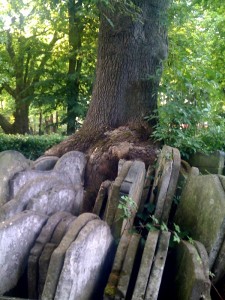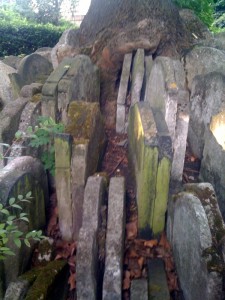Creation myths and creativity
What do you bury before it is dead, and the more it rots in the ground, the more life bursts from it?
This tree is in St Pancras churchyard. In the 1860’s a railway was built through part of the churchyard. A young man was given the job of digging up the graves and re-locating the grave stones. He placed the stones against a tree. The stones have never been moved. The tree has grown around them, the trunk expanding around the stones. The grave stones are embedded in the living tree. The tree is still growing. And the young man grew into Thomas Hardy – the wonderful English novelist. Death and new life are intertwined.
The image of life growing out of death occurs in creation myths. An Egyptian myth describes a tree growing up, and enclosing the coffin of god Osiris. A Byzantine myth describe a tree growing from dead Adam’s mouth. The tree becomes the wood of the cross on which Christ is crucified.
Most creation myths begin with darkness. In this dark space, creation occurs through: desire; thought; breath; speech; wind; fire; hunger; sweat; boredom; sound; and loneliness. Creation also happens by accident or mistake. Or by something bursting out of nothing. Jungian writer Marie-Louise Von Franz, in her book Creation myths, discusses how our hidden creative processes are mirrored in the patterns of creation myths. So the images in myths can be used as impulses to encourage and help our creativity.
Von Franz typifies creation myths as either a movement from above to below, or a movement from below to above. In myths with the movement from above – something descends from another world and creates our world. The Finnish ‘Kalevala’ describes a girl, a maiden of the air, who gets bored and floats down through the air. Earth comes into being from the need for somewhere for her to rest. In myths with the movement from below – the process of creation starts underground and bubbles up or bursts through. Myths found throughout the Pacific Islands follow this pattern. The god Tangaroa strikes a rock, and light, water, sky, animals, and humans burst forth.
Traditional stories might appear dusty, old, even dead. They demand creative work to give them new meaning for new audiences. This creative process seems to works best if at least some of it happens in the dark! Stories need fallow time, they need to lie in the dark soil, undisturbed and in secret. Then they need feeding – through research, dreaming, shaping. Then embodying- through breath and speech, sweat and fire. And most of all the storyteller needs hunger, the desire to bring this tale back to life.
Answer to the riddle : a seed



Leave a Reply